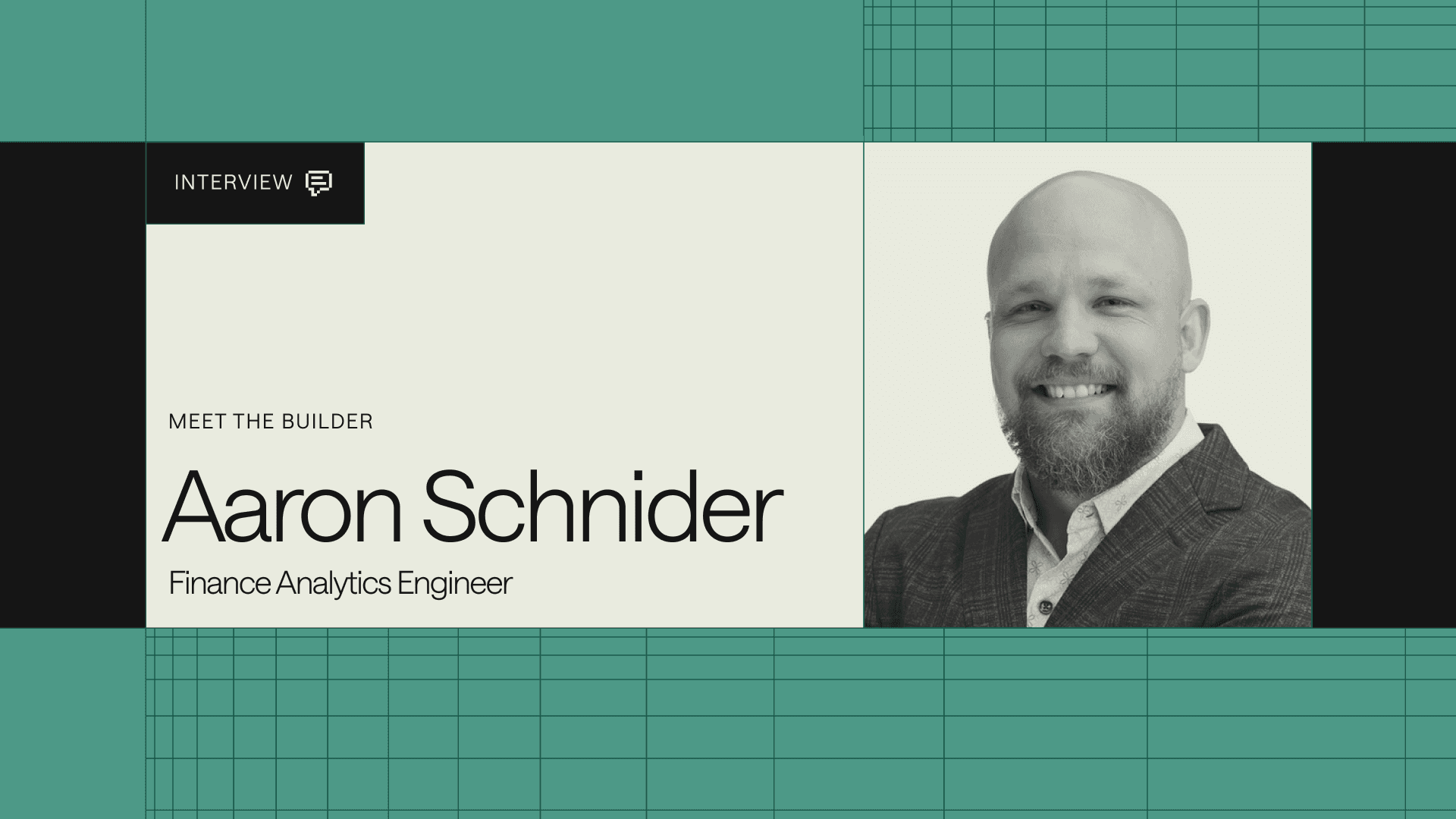Modern dev approaches, including AI coding assistants, have fundamentally shifted who can build production-ready applications. Domain experts—technically-minded process owners with problems software can solve—now have the right tools to do the job. But what does that look like in practice?
Aaron Schnider embodies this new type of accelerated builder. As a finance analytics engineer at Lithic, which provides financial infrastructure powering payment cards and other money movement, he combines deep business context with developer-friendly tooling to create applications that entire teams depend on. With the right AI tools—and in the right environment—he’s built production-ready solutions without the usual hurdles that limit domain experts.
We sat down with Aaron to learn more about his unconventional path to building software, his process, and what others should know about turning domain knowledge into production-ready applications.
Aaron started his journey as a CPA—working in public accounting, doing bookkeeping, payroll, and taxes. After a few years, he moved towards data roles.
“I’ve always been at the intersection of finance and data,” Aaron said.
It was crypto that ultimately brought him into tech. In 2021, he saw a job opening at digital asset exchange Kraken and landed his first role as a senior finance data analyst. Tech jobs have long had a reputation for affording workers the opportunity to move fast, find efficiencies, and work independently to solve problems.
“If a process isn’t working the way it should be working, I naturally tend to think, ‘this isn’t efficient, we need to automate it,’” Aaron explains. “Even if that meant spending an additional eight hours creating the automation, I feel like the upfront investment is worth it from a process perspective.”
At Lithic, Aaron combines his experience as a CPA and his passion for data to bridge the communication gap between finance and engineering teams. As a financial data expert, he’s now uniquely equipped to solve specific problems.
“A data person who doesn’t have any finance background can build the pipelines, but they won’t actually know if the numbers are right,” he says.
When Aaron realized he was going to take over a complex billing process at Lithic and there was no application to support it, he knew exactly what he needed to build.
Aaron’s domain—the back office—makes work possible. Back-office processes like contract management, billing calculations, and financial reporting are critical pieces of business infrastructure. But they’re often underserved by existing software solutions.
“Back offices are a bunch of processes that have to work together,” Aaron explains. “Applications can serve two purposes: one, as an interface to the data objects where you can safely get information into the database; but two, also operational efficiency—how can we have humans interact better?”

hen it comes to engineering hours and investment, back-office systems have long taken a backseat to customer-facing applications and products. It’s no surprise, then, that so many back offices run on spreadsheets—a reliable, affordable mainstay.
But when spreadsheets (and copies of copies of spreadsheets) become the process…that’s when a purpose-built application can solve a lot of problems.
“I wasn’t going to write, insert, and update statements manually. I would rather spend time cranking out an application over the weekend,” Aaron says. In about two to three weeks, as he was ramping into his new role, he had built what would become Bill Buddy—an essential billing app with a cowboy theme that’s become beloved not only for its utility, but its personality.
Instead of building another anonymous internal app, Aaron created a character—a mascot for a process that could otherwise be pretty dry. That kind of personality helped the app stick. People across the company even started creating and sharing their own Bill Buddy AI art.

“Billing is inherently boring. So when you’ve got the power to prototype your own apps, why not give them some flair,” Aaron shares.
Less than three months after launching his prototype, he was demoing Bill Buddy at an all-hands meeting. “In the comments, founders and executives were saying ‘this is amazing, we really love this,’” he recalls. “I thought, ‘Heck ya, I’m putting that feedback on my refrigerator.’”
Bill Buddy serves two key functions. First, it helps Aaron get contract information into Lithic’s billing engine instead of relying on the spreadsheets they were using before. The application ensures data flows into a structured database through a controlled interface.
But Bill Buddy also gives internal users up-to-date, customer-specific insights from that database beyond SQL queries and reports.

Bill Buddy caught on quickly with read-only business users who have come to rely on it for the latest information. These users span the entire deal lifecycle: sales teams want visibility into deals they've just landed, while downstream accounting teams need that same information to process billing.
“You can’t expect a non-technical operator to write complex code to get information into the system. They need an application to do it,” Aaron says. “Now we can pass this responsibility off to a non-technical user.”
Apps like Bill Buddy are small in scope but bring a big, essential impact on a back-office process. They’re exactly the kind of tailored solutions that domain experts are uniquely positioned to build and scale—they’re not something you can just buy.
Aaron (and builders like him) have another advantage: direct experience with the processes they’re trying to optimize. Aaron’s background gives him unique insight into what finance stakeholders actually need, not just what they think they want.
“I feel like that’s my superpower—having empathy for the stakeholder.”
He often sees a communication breakdown happen when technical and business teams think they’re talking about the same thing, but they’re actually operating with completely different mental models.
“When you’re working with stakeholders, there’s always a communication barrier,” says Aaron. “If I say ‘a house’ and you say ‘a house,’ how do we both know that we’re saying the same thing? Are we talking like a Western Colonial or an apartment?”
Understanding the stakeholder’s terms and parameters—what “house” you’re both trying to build—is the key to getting as close to the right solution as possible the first time.
When a finance person insists they need data presented in a specific way, there’s usually a business reason that pure technologists miss. Aaron’s dual background lets him translate between these worlds.
“I feel like that’s my superpower—having empathy for the stakeholder,” he shares.
Understanding both the technical constraints and the business imperatives driving challenging requests, Aaron can bridge the gap to build the right solution for the problem at hand—one that can serve multiple users across the organization
Getting buy-in for new applications requires delicate timing and strategic thinking. Plenty of domain experts can recognize problems in their processes, but too few have time to think through real solutions. As disconnected back-office processes grow, their problems grow with them.
“People who are in the weeds of that process probably aren’t necessarily concerned about making something amazingly better,” Aaron notes. “They’re really just concerned about closing the books by Friday.”
He’s found that building trust through small wins lays the groundwork for proposing larger changes.
“You don’t want to go in saying, ‘Hey, we’re going to completely change everything.’ I start with something that only impacts my own personal workflow, and then little by little, expand,” Aaron says.
“I start with something that only impacts my own personal workflow, and then little by little, expand.”
To borrow from his earlier house example, prove yourself in your own backyard before redesigning the neighborhood.
or Aaron, AI coding approaches provide a space to experiment and validate ideas quickly without requiring extensive engineering resources upfront.
“I’ve had some pretty novel, unexpected outcomes,” he shares. “Sometimes AI throws out wonky ideas, but sometimes it leads to something that I hadn’t really thought about.”
The vibe coding era means that anyone with a problem to solve can (theoretically) build and test prototypes without looping in engineers and without taking a ton of time. But vibe coding has its limits when apps need to be production-ready and secure enough for internal company or customer data.
As a domain expert, Aaron can prototype and validate quickly and independently using AI. Having the right business context gives his tests the right guardrails.
Aaron’s accounting background gives him an easy path to testing and validating his prototypes: “A lot of my stuff leads to accounting numbers. It’s easy to tell when something went wrong.”
Instead of forcing business processes into rigid SaaS tools or waiting for engineering resources, domain experts like Aaron can now build exactly what their processes require. Aaron’s applications don’t just solve his immediate problems; they create reliable systems that entire teams can depend on.
The core of those systems? Clean, secure data
“I want good, clean data that people can rely on,” Aaron explains. “How do I get that data into the system, not as a separate process that someone has to remember to do, but actually as part of a process that someone’s naturally doing?”
Apps like Bill Buddy are also secure by default. Business users at Lithic can add invoices and know the information they’re uploading is safe and operating within company norms. And Aaron can keep expanding his internal app ecosystem.
For other professionals who see broken processes but think they’re not technical enough to fix them, Aaron’s advice is straightforward: “Just sit down, map it out, whiteboard it. Really try to break down the process and figure out what it is you’re actually doing.”
Builders like Aaron understand both the problem and the solution in ways that pure technologists, pure business users, and even AI can’t. He’s already working on his next big project, and he’s excited for what the future of building looks like for this new group of builders.
“I think there’s more opportunity to put creativity into production,” Aaron reflects. “Every new tool that lowers the barrier doesn’t just make building easier, it opens up entirely new ways to solve problems.”
Lithic provides financial infrastructure that enables teams to build better payments products for consumers and businesses.
Reader






